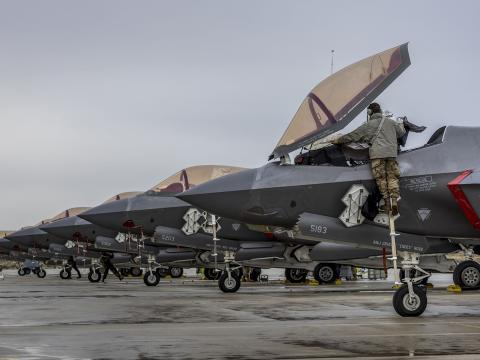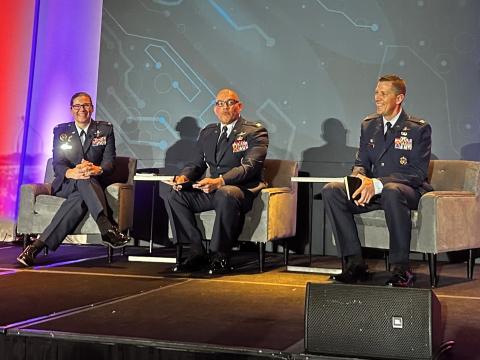Concept Design Center Teams Explore Future Space-Based Tools
Engineers and customers collaborate to analyze effectiveness of proposed innovative technologies.
A synergistic interaction between experts, processes and technology is producing concepts of space systems for the U.S. Air Force that will effectively use current and planned assets to address future warfighters’ needs. In a corporate facility dedicated to maximizing a coordinated team approach, specialists in utility, availability, cost, power, propulsion, software and payloads develop consistent point designs in as little as three days.
The work is being conducted under the auspices of the Air Force’s Space and Missile Systems Center’s developmental planning directorate (SMC/XR), Los Angeles Air Force Base, with the support of The Aerospace Corporation, Los Angeles. The company supplies a dedicated concept design center (CDC) that allows technicians and customers to conduct studies in an environment that facilitates concurrent design and engineering. According to CDC personnel, this approach contributes to cost reduction and improved products.
The SMC/XR’s mission is to design new technologies and space systems as well as integrate multiple space and air missions for classified and unclassified programs. Ultimately, the directorate develops space concepts that solve future warfighters’ needs through the analysis and evaluation of current and proposed space systems.
According to Col. Robert S. Cox, USAF, former director of the SMC/XR, the organization’s systems engineering and integration as well as its plans and analysis units house unique, state-of-the-art analytical and engineering tools that facilitate the development of future concepts. In addition, representatives from the Air Force Research Laboratory (AFRL), National Aeronautics and Space Administration, National Reconnaissance Office (NRO), Space Mission Integration Office, Air Force/NRO Integration Planning Group, and Aerospace Command and Control, Intelligence, Surveillance and Reconnaissance Center (AC2ISRC) provide the comprehensive link to take advantage of collaborative development efforts in projects involving space.
Teams within the SMC/XR’s systems engineering and integration division are appropriately nicknamed “thrust areas” because they are charged with addressing near-term future Air Force space capabilities. These thrust areas currently include space-based radar, a space maneuvering vehicle, the global multimission service platform (GMSP), hyperspectral imaging, information operations/warfare, aerospace expeditionary forces and commercial exploitation. By developing engineering analysis and early cost estimates, these individual areas will be ready to evolve into major system program offices once a corporate decision is made to do so, Col. Cox says.
The plans and analysis division is SMC/XR’s concept development engine. It includes three branches: technical planning integrated product teams (TPIPTs); concept development and modeling; and simulations and analysis. Using the Air Force modernization planning process, the TPIPTs work with the Air Force Space Command (AFSPC), the AFRL and industry to develop concepts to meet the AFSPC’s needs.
These concepts are then referred to the concept development branch, which adds more details to them. This group uses tools such as the CDC to conduct system architecture and performance trades as well as to examine cost, schedule, risk and technical aspects of the concept automatically.
Following development, the modeling, simulations and analysis branch validates the concept by conducting military utility analysis. It uses Air Force-validated models such as the system effectiveness analysis simulation to determine a space system’s likely contribution to an approved defense planning guidance conflict scenario.
Col. Cox says that the developmental planning directorate relies heavily on the CDC for concept design and analysis. It is the only military space tool capable of automated system engineering trades, applying integrated collaborative engineering that allows a customer to interact with the team of engineers and designers, and it can lead to a finished product in as little as two months. To date, the CDC has helped mature concepts such as space-based data relay, navigation communications (NAVCOMM), GMSP and space-based radar, he offers.
The Aerospace Corporation created the CDC to support the government’s development of conceptual systems designs and architectures across a range of potential missions. CDC teams were established to perform conceptual design trade studies that support acquisition planning activities such as those of the developmental planning directorate. Short duration studies, on the order of one to two months, that explore design alternatives or analyze proposals, constitute the bulk of the CDC’s activities.
Studies typically are characterized by three phases: preparation, design sessions and documentation. Preparation for a study often takes a considerable amount of time and planning, Col. Cox points out. During this phase, the trades that will be performed are structured, and team members prepare their tools for the session. The sessions are the actual integrated collaborative engineering activity aimed at producing all of the study results in a short period of time. Multiple configurations or architectures for a system are examined during this phase.
Sessions typically last two to four days and involve all members of the team as well as the customer. They are held in a computer facility that enables both electronic and face-to-face communications.
During the design sessions, the customer, experts and tools are all co-located in this dedicated CDC facility. This supports the critical exchange of information and builds understanding by all members of the team, especially the customer, the colonel says. Those using the design tools do not attempt to capture all aspects of a concept; broad elements of a concept that are best communicated verbally remain to be defined in the final documentation. A complete report describing the study is then prepared by each team member, including the customer. The report contains assumptions, design details and recommendations.
While the attributes are similar across all of the CDC teams, the actual implementation of problem decomposition, team creation and level of technical detail varies widely and is tailored to the specific task.
CDC groups are composed of experts from a variety of organizations within The Aerospace Corporation’s engineering and technology group. Rather than relying on individuals and fixed team membership, teams are assembled on an as-needed basis with personnel drawn from appropriate Aerospace functional departments. This is not to imply that any collection of disciplines can be combined in a CDC team, Col. Cox says. Rather, specific collections of disciplines have been identified for addressing certain types of tasks. Considerable effort has been invested in developing processes and tools, as well as approaches for managing and leading teams in this environment, he adds.
The integrated navigation and mobile communication architecture study is an example of how the CDC develops concepts. The Aerospace Corporation’s lead system engineer, Dr. Lubo Jocic, proposed the idea of integrating navigation and mobile/personal communication services as part of the Air Force modernization planning process and global positioning system (GPS) modernization analyses of alternatives. Over several study iterations, this concept, now the GMSP, currently is part of the GPS III architecture trade space.
The concept’s developers considered opportunities for integrating navigation and mobile communication satellites and user terminals that will improve navigation and communication services to enhance situational awareness and leverage commercial trends. To further develop the concept, the CDC conducted a system-of-systems architecture study that identified 24 baseline architectures to address the Air Force’s projected communication and navigation needs. Engineers participating in the NAVCOMM/GPS modernization architecture study included specialists in spacecraft, payload, constellation, availability, launch, control segment and cost.
The CDC study evaluated both separate and integrated navigation and mobile/personal communication systems. The concepts included the GPS modernization analysis of alternative working group proposals, industry’s GPS augmentation request for information input, and Jocic’s NAVCOMM concepts. The Air Force’s NAVSTAR GPS joint program office contributed Boeing’s GPS IIF design and government costing information, while Hughes and Lockheed-Martin, as corporate partners, participated in several CDC sessions to confirm fine calibration of The Aerospace Corporation’s CDC models.
Twelve viable architectural alternatives emerged from the CDC’s spacecraft, payload, constellation, availability, launch, control segment and cost trades. Six alternatives with navigation-only satellites include currently planned mobile communication assets—eight ultrahigh frequency follow-on (UFO) satellites as well as commercial Globalstar service with associated per-minute charges. Six alternatives with NAVCOMM satellites employ four UFOs for global service and reduced usage of Globalstar. NAVCOMM satellites provide communication signals and 25- to 30-decibels-stronger military navigation signals from space as a navigation warfare (NAVWAR) substitute for nullers on all military user equipment and ground/airborne military pseudolites.
The team drew several conclusions: Combining navigation and communication services could reduce GPS modernization life-cycle costs by 20 percent. GPS and U.S. Defense Department mobile communication modernizations could be accomplished within the historic GPS and UFO budgets and the projected NAVWAR and Federal Aviation Administration wide area augmentation system budget.
Doing nothing in space for NAVWAR or restricting space enhancements to the GPS IIF modifications may prove to be expensive. In these cases, the burden of performance enhancements and requirements satisfaction is offloaded to user equipment and extensive ground augmentations.
Further examination of cost projections revealed that foreign ownership of an independent competing system could prove to be one of the least expensive alternatives. However, this approach may be unacceptable due to the lack of U.S. control and associated availability risks. Independent U.S. civil and military navigation systems are expensive because of hardware duplications. Independent ownership, operations and control of augmentations carries a 30 percent surcharge. International sharing using regional geosynchronous earth orbit augmentations may be a viable alternative.
New navigation systems to replace GPS will cost about as much as GPS before transition costs and delays are factored in.
The increased capabilities and savings potential of consolidated military mission architectures warrant further investigation due to service synergy and cost sharing across missions.
Since the conclusion of this study, the CDC has conducted several iterative studies to fine-tune the concept. Recently, the space segment CDC team further defined the spacecraft characteristics. In addition, the types of missions have expanded beyond navigation and communication to Blue Force tracking and polar military satellite communications.
While conducting studies, the CDC also is building new capabilities. Additional CDC teams have been formed to study kinetic energy weapons, communications payloads and reusable launch vehicles. The Aerospace Corporation also is exploring a distributed CDC, which would enable specialists to conduct CDC studies concurrently with other geographically separated organizations. In the end, these new capabilities will help the SMC/XR and the rest of the government to better plan future space missions, Col. Cox predicts.
Capt. Allan D. Bartolome, USAF, is chief, concept development branch, U.S. Air Force Space and Missile Systems Center developmental planning directorate. Scott Gustafson is director, concepts and technology department; and Steve Presley is associate director, concept design center office, The Aerospace Corporation.



